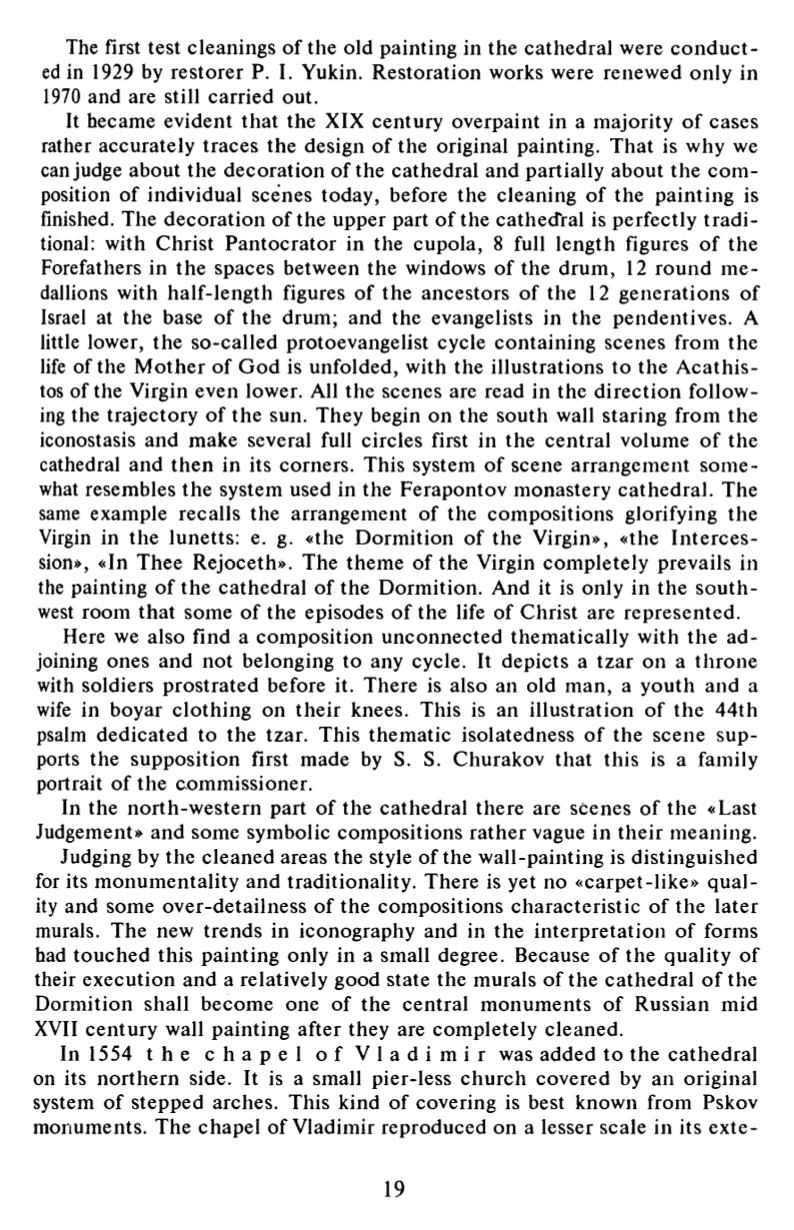

The first test cleanings o f the old painting in the cathedral were c o n d u c t
ed in 1929 by restorer P. I. Yukin. Restoration works were renewed only in
1970 and are still carried out.
It hecame evident that the XIX century overpaint in a majority o f cases
rather accurately traces the design o f the original painting. That is why we
can judge about the decoration of the cathedral and partially about the c om
position of individual scenes today, before the cleaning o f the painting is
finished. The decoration o f the upper part o f the cathedral is perfectly tr a d i
tional: with Christ Pan tocrator in the cupola, 8 full length figures o f the
Forefathers in the spaces between the windows o f the drum, 12 round m e
dallions with half-length figures of the ancestors of the 12 generations of
Israel at the base o f the drum; and the evangelists in the pendentives. A
little lower, the so-called protoevangelist cycle containing scenes from the
life of the Mo the r of God is unfolded, with the illustrations to the Acath is-
tos of the Virgin even lower. All the scenes are read in the d irec tion follow
ing the trajectory o f the sun. They begin on the south wall staring from the
iconostasis and make several full circles first in the central volume o f the
cathedral and then in its corners. This system o f scene arrangement some
what resembles the system used in the Ferapontov monastery cathedral. The
same example recalls the arrangement of the compositions glorifying the
Virgin in the lunetts: e. g. «the Dormition o f the Virgin», «the In te r c e s
sion», «In Thee Rejoceth». The theme of the Virgin completely prevails in
the painting o f the cathedral of the Dormition. And it is only in the s o u th
west room that some o f the episodes o f the life of Christ are represented.
Here we also find a composition unconnected thematically with the a d
joining ones and not belonging to any cycle. It depicts a tza r on a throne
with soldiers prostrated before it. There is also an old man, a youth and a
wife in boyar clothing on their knees. This is an illustration o f the 44th
psalm dedicated to the tzar. This thematic isolatedness o f the scene sup
ports the supposition first made by S. S. Churakov that this is a family
portrait o f the commissioner.
In the north -weste rn part o f the cathedral there are scenes o f the «Last
Judgement» and some symbolic compositions rather vague in their meaning.
Judging by the cleaned areas the style of the wall-painting is distinguished
for its monumen tality and traditionality. There is yet no «carpet-like» qu a l
ity and some over-detailness o f the compositions characteristic o f the later
murals. The new trends in iconography and in the in terpretation o f forms
had touched this painting only in a small degree. Because o f the quality of
their execution and a relatively good state the murals o f the cathedral o f the
Dormition shall become one of the central monumen ts o f Russian mid
XVII cen tury wall painting after they are completely cleaned.
In 1554 t h e c h a p e l o f V l a d i m i r was added to the cathedral
on its no rthern side. It is a small pier-less chu rch covered by an original
system o f stepped arches. This kind of covering is best known from Pskov
monuments. The chapel of Vladimir reproduced on a lesser scale in its ex te
19















